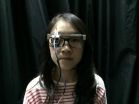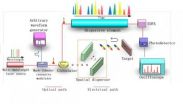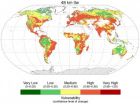(Press-News.org) Imagine trying to measure a tennis ball that bounces wildly, every time to a distance a million times its own size. The bouncing obviously creates enormous "background noise" that interferes with the measurement. But if you attach the ball directly to a measuring device, so they bounce together, you can eliminate the noise problem.
As reported recently in Nature, physicists at the Weizmann Institute of Science used a similar trick to measure the interaction between the smallest possible magnets – two single electrons – after neutralizing magnetic noise that was a million times stronger than the signal they needed to detect.
Dr. Roee Ozeri of the Institute's Physics of Complex Systems Department says: "The electron has spin, a form of orientation involving two opposing magnetic poles. In fact, it's a tiny bar magnet." The question is whether pairs of electrons act like regular bar magnets in which the opposite poles attract one another.
Dr. Shlomi Kotler performed the study while a graduate student under Dr. Ozeri's guidance, with Drs. Nitzan Akerman, Nir Navon and Yinnon Glickman. Detecting the magnetic interaction of two electrons poses an enormous challenge: When the electrons are at a close range – as they normally are in an atomic orbit – forces other than the magnetic one prevail. On the other hand, if the electrons are pulled apart, the magnetic force becomes dominant, but so weak in absolute terms that it's easily drowned out by ambient magnetic noise emanating from power lines, lab equipment and the earth's magnetic field.
The scientists overcame the problem by borrowing a trick from quantum computing that protects quantum information from outside interference. This technique binds two electrons together so that their spins point in opposite directions. Thus, like the bouncing tennis ball attached to the measuring device, the combination of equal but opposite spins makes the electron pair impervious to magnetic noise.
The Weizmann scientists built an electric trap in which two electrons are bound to two strontium ions that are cooled close to absolute zero and separated by 2 micrometers (millionths of a meter). At this distance, which is astronomic by the standards of the quantum world, the magnetic interaction is very weak. But because the electron pairs were not affected by external magnetic noise, the interactions between them could be measured with great precision. The measurement lasted for 15 seconds – tens of thousands of times longer than the milliseconds during which scientists have until now been able to preserve quantum data.
The measurements showed that the electrons interacted magnetically just as two large magnets do: Their north poles repelled one another, rotating on their axes until their unlike poles drew near. This is in line with the predictions of the Standard Model, the currently accepted theory of matter. Also as predicted, the magnetic interaction weakened as a function of the distance between them to the power of three.
In addition to revealing a fundamental principle of particle physics, the measurement approach may prove useful in such areas as the development of atomic clocks or the study of quantum systems in a noisy environment.
INFORMATION:
Dr. Roee Ozeri's research is supported by the Crown Photonics Center; the Yeda-Sela Center for Basic Research; the Wolfson Family Charitable Trust; Martin Kushner Schnur, Mexico; Friends of the Weizmann Institute of Science in Memory of Richard Kronstein; and the Zumbi Stiftung.
The Weizmann Institute of Science in Rehovot, Israel, is one of the world's top-ranking multidisciplinary research institutions. Noted for its wide-ranging exploration of the natural and exact sciences, the Institute is home to scientists, students, technicians and supporting staff. Institute research efforts include the search for new ways of fighting disease and hunger, examining leading questions in mathematics and computer science, probing the physics of matter and the universe, creating novel materials and developing new strategies for protecting the environment.
Weizmann Institute news releases are posted on the World Wide Web at http://wis-wander.weizmann.ac.il, and are also available at http://www.eurekalert.org.
Measuring the smallest magnets
2014-07-28
ELSE PRESS RELEASES FROM THIS DATE:
Social network research may boost prairie dog conservation efforts
2014-07-28
Researchers using statistical tools to map social connections in prairie dogs have uncovered relationships that escaped traditional observational techniques, shedding light on prairie dog communities that may help limit the spread of bubonic plague and guide future conservation efforts. The work was done by researchers from North Carolina State University and the National Evolutionary Synthesis Center (NESCent).
"Prairie dogs are increasingly rare and are subject to bubonic plague," says Dr. Jennifer Verdolin, lead author of a paper on the work and an animal behavior ...
Motivation explains disconnect between testing and real-life functioning for seniors
2014-07-28
A psychology researcher at North Carolina State University is proposing a new theory to explain why older adults show declining cognitive ability with age, but don't necessarily show declines in the workplace or daily life. One key appears to be how motivated older adults are to maintain focus on cognitive tasks.
"My research team and I wanted to explain the difference we see in cognitive performance in different settings," says Dr. Tom Hess, a professor of psychology at NC State and author of a paper describing the theory. "For example, laboratory tests almost universally ...
Wearable device for the early detection of common diabetes-related neurological condition
2014-07-28
WASHINGTON, July 28, 2014—A group of researchers in Taiwan has developed a new optical technology that may be able to detect an early complication of diabetes sooner, when it is more easily treated. If the device proves safe and effective in clinical trials, it may pave the way for the early detection and more effective treatment of this complication, called diabetic autonomic neuropathy, which is common among people with both Type 1 and Type 2 diabetes. The condition progressively affects the autonomic nerves controlling vital organs like the heart and gastrointestinal ...
Potential 'universal' blood test for cancer discovered
2014-07-28
Researchers from the University of Bradford, UK, have devised a simple blood test that can be used to diagnose whether people have cancer or not.
The test will enable doctors to rule out cancer in patients presenting with certain symptoms, saving time and preventing costly and unnecessary invasive procedures such as colonoscopies and biopsies being carried out. Alternatively, it could be a useful aid for investigating patients who are suspected of having a cancer that is currently hard to diagnose.
Early results have shown the method gives a high degree of accuracy ...
Gender inequalities in health: A matter of policies
2014-07-28
A new study of the European project SOPHIE has evaluated the relationship between the type of family policies and gender inequalities in health in Europe. The results show that countries with traditional family policies (central and southern Europe) and countries with contradictory policies (Eastern Europe), present higher inequalities in self-perceived health, i.e. women reported poorer health than men. Health inequalities are especially remarkable in Southern Europe countries, where women present a 27% higher risk of having poor health compared to men.
The authors of ...
Serial time-encoded amplified microscopy for ultrafast imaging based on multi-wavelength laser
2014-07-28
Ultrafast real-time optical imaging is an effective and important tool for studying dynamical events, such as shock waves, neural activity, laser surgery and chemical dynamics in living cells. Limited by the frame rate, conventional imaging system such as charge-coupled device (CCD) and complementary metal oxide semiconductor (CMOS) imaging device can not image fast dynamic processes. Last few years, serial time-encoded amplified microscopy (STEAM) technique based on space-frequency mapping combined with frequency-time mapping has been demonstrated as a completely new optical ...
Study finds Europe's habitat and wildlife is vulnerable to climate change
2014-07-28
New research has identified areas of the Earth that are high priorities for conservation in the face of climate change.
Europe is particularly vulnerable, as it has the lowest fraction of its land area, only four per cent, of any continent in 'refugia' – areas of biological diversity that support many species where natural environmental conditions remain relatively constant during times of great environmental change. The refugia that do exist in Europe are mostly in Scandinavia and Scotland.
The biggest refugia are in the Amazon, the Congo basin, the boreal forests ...
Why do dogs smell each other's behinds? Chemical communication explained (video)
2014-07-28
WASHINGTON, July 28, 2014 — Here at Reactions, we ask the tough questions to get to the bottom of the biggest scientific quandaries. In that spirit, this week's video explains why dogs sniff each other's butts. It's a somewhat silly question with a surprisingly complex answer. This behavior is just one of many interesting forms of chemical communication in the animal kingdom. Find out more at http://www.youtube.com/watch?v=PZlJ8XfwiNg.
Subscribe to the series at Reactions YouTube, and follow us on Twitter @ACSreactions to be the first to see our latest videos.
INFORMATION:
The ...
Refrigerator magnets
2014-07-28
CAMBRIDGE, MA -- The magnets cluttering the face of your refrigerator may one day be used as cooling agents, according to a new theory formulated by MIT researchers.
The theory describes the motion of magnons — quasi-particles in magnets that are collective rotations of magnetic moments, or "spins." In addition to the magnetic moments, magnons also conduct heat; from their equations, the MIT researchers found that when exposed to a magnetic field gradient, magnons may be driven to move from one end of a magnet to another, carrying heat with them and producing a cooling ...
Children with disabilities benefit from classroom inclusion
2014-07-28
COLUMBUS, Ohio – The secret to boosting the language skills of preschoolers with disabilities may be to put them in classrooms with typically developing peers, a new study finds.
Researchers found that the average language skills of a child's classmates in the fall significantly predicted the child's language skills in the spring – especially for children with disabilities.
The results support inclusion policies in schools that aim to have students with disabilities in the same classrooms alongside their typically developing peers, said Laura Justice, co-author of the ...





